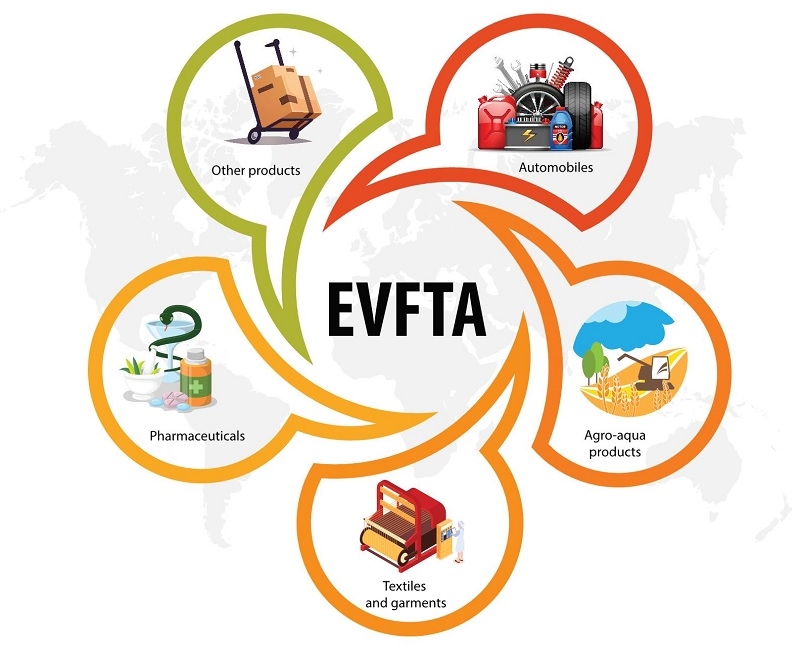EU deal to force blanket progress
 |
| Do Thanh Huyen, assistant manager of business intelligence at consultancy firm Dezan Shira & Associates |
February 12 marked a milestone in bilateral economic relations between the EU and Vietnam when the European Parliament ratified the EU-Vietnam Free Trade Agreement (EVFTA) with 401 votes in favour. Finally, after eight years of negotiations, the EVFTA is closing in on implementation. The Vietnamese National Assembly has tabled this agreement for discussion and could ratify the agreement in May. The EVFTA will cut almost 99 per cent of customs duties between the EU and Vietnam, opening up many opportunities but also inevitable obstacles that Vietnam must overcome.
The EU has always been a high-potential and significant market for Vietnamese products. Data from Vietnam Customs showed that the country’s 2019 exports to the EU valued $41.7 billion, equivalent to exports to China.
Once the EVFTA is ratified, local entrepreneurs will face challenges due to stricter guidelines prescribed by the agreement on rules of origin, product quality standards, and requirements for labour and working conditions. Vietnamese enterprises not only have to confront higher competitiveness in domestic market but they are also exposed to risk of trade remedies levied by EU countries when their products penetrate the EU market.
Agro-aqua products
Vietnam is a country that thrives on agriculture with a multitude of products affirming their position in the EU market. After the EVFTA enters into force, EU custom duties on Vietnamese products like coffee, natural honey, and fresh fruit and vegetables will be completely eliminated. Tariffs on other key products such as rice, fish, and sugar will be reduced gradually and ultimately removed in the next three to seven years.
However, Vietnam’s agricultural and seafood exports have been facing certain difficulties amid global economic integration and trade liberalisation. The EU is a fastidious market where the annual average income is $36,000, three times higher than that of China’s. EU authorities set high standards for product quality and requirements on food safety, labelling, and the environment.
To be entitled for EVFTA benefits, Vietnamese businesses shall conform to EU standards. Furthermore, sanitary and phytosanitary measures as non-tariff barriers are also covered in the agreement.
In order to be eligible for imports in the EU, Vietnamese goods must follow such strict requirements, particularly on food safety. Food safety and traceability are likely the most challenging barrier for Vietnamese agricultural and aquatic goods in foreign markets.
In such a context, the EVFTA urges Vietnamese businesses, especially small- and medium-sized ones, to advance their technology, apply higher standards to their processing lines, and cut the use of restricted substances and antibiotics for production.
Textiles and garments
Labour-intensive industries have become Vietnam’s comparative advantage. As reported by the General Statistics Office in 2019, Vietnam’s exports of textiles and garments ranked third globally with a value of $32.6 billion, only after China and India. Meanwhile, the EU is the second-largest market for Vietnamese apparels, which makes these products among the most beneficial groups when the EVFTA comes into force. Nevertheless, it is important for manufacturers of this product group to be proactive in sourcing materials to meet the “yarn forward” rules of origin. In essence, this means that all items in a garment from the yarn stage must be made in the EU, Vietnam, or South Korea – the only mutual FTA partner of both EVFTA’s parties. According to Vinatex, around 14 per cent of Vietnam’s garment inputs in 2019 were imported from South Korea.
The rule is intended to ensure that the trade benefits of the EVFTA only apply to signatory countries rather than outside players.
These origin rules could have a serious impact for countries like Vietnam. The country is currently a key global garment manufacturing hub. However, fabrics are mostly sourced from China. Overall, around 85 per cent of Vietnamese textile and garment companies have outsourcing contracts with foreign partners. Vietnam should place top priority on the development its own local fabric industry to be eligible for EVFTA benefits.
 |
| Domestic groups across various sectors will be affected by new EVFTA requirements |
Pharmaceuticals
Vietnam’s pharmaceutical market remains attractive to EU investors. Once the EVFTA comes into effect, approximately half of EU pharmaceutical imports will be duty-free immediately, with the rest exempted after seven years.
While Vietnam’s pharmaceutical market has significantly developed, it still only meets 52 per cent of market demand, contributed mostly by generic drugs. The new FTA will further open the market allowing local consumers to find “Made in EU” pharmaceutical products on store shelves, and at a competitive price. Vietnamese manufacturers might struggle to maintain their market share without constant innovation and improvements in their product lines, as it is likely that local consumers will perceive “Made in EU” pharmaceuticals as higher quality products.
Automobiles
As the domestic automobile industry remains in its infancy, Vietnam’s commitment in the EVFTA is a roadmap of gradual reduction of custom duties on EU automobiles in 10 years so that local carmakers can strengthen their positions. Nevertheless, it is doubtful that the Vietnamese automotive industry will sufficiently develop to embrace the challenge from EU products.
Notable carmakers such as VinFast, THACO, and Huyndai Thanh Cong have been selling at lower prices to compete with EU-made products. However, the main challenge for local players will be the development of an appropriate supporting industry. Currently, there are roughly 250 Vietnamese companies operating in the field of automotive component manufacturing.
The uneven production of automobiles by Vietnamese enterprises also prevents the local automotive industry from receiving the EVFTA’s tariff preferences when it gets access to the EU market. As per the agreement, the value limit of non-originating materials for vehicle and vehicle parts are specified at 45 and 50 per cent, respectively.
Thus, Vietnam will have to promote its own supporting industries for automobiles or import components from EU member states in order to take advantage of the EVFTA.
Other products
In general, all Vietnamese products exported to EU member states are also exposed to the risk of their trade remedies. When a tariff is no longer an effective barrier, foreign markets tend to resort to anti-dumping, anti-subsidy, or safeguard measures to protect their industries and their consumers. It is important to note that the EU is such a market which prefers to implement such measures. Indeed, anti-dumping duty has been levied on several of Vietnam’s key commodities such as steel, basa fish, or shrimp, by major markets such as the US, Canada, India, the EU, and several other FTA partners.
Trading of services and investment
Vietnam commits to opening the market for business, environmental, and logistic services, as well as banking, insurance, and sea freight services by EU member states. Therefore in upcoming years, Vietnamese service providers are likely to encounter EU competitors and find it harder to assert their positions in the domestic market.
Currently, EU investors are active in 18 economic sectors and in 52 out of 63 provinces in Vietnam. Investment has been the most prominent in manufacturing, electricity, and real estate. Incentives under the EVFTA granted for EU investors may create challenges for local manufacturers of food and beverages, fertilisers, tyres, pottery, plastic products, and construction materials. This is likely when there is a gap in capacity and product quality between domestic and foreign-invested companies.
In addition, the EVFTA also triggers another challenge for Vietnamese companies in terms of international labour standards. According to a recently-published Oxfam study on Vietnamese garment workers’ wages and living conditions, the national average minimum wage in Vietnam is $143.70, which is around 37 per cent of the Asia Floor Wage and 64 per cent of the Global Living Wage Coalition benchmark.
Workers’ wages are being kept quite low so manufacturers can reduce prices for international buyers, who always seek the cheapest option. As Vietnamese labour is progressing towards international standards to enter the EVFTA, local enterprises have no choice but to bear the increased labour cost, which requires them to seek for other ways to maintain their competitiveness.
Conclusion
The agreement is predicted to come into force in July or August this year. We strongly recommend that Vietnamese companies thoroughly understand the commitments of both parties in the EVFTA and be prepared to embrace upcoming challenges.
In such a context, being proactive is crucial for enterprises to maintain their performance and expand their business. The EVFTA presents a chance for Vietnamese businesses to improve themselves to be able to compete with EU enterprises and develop a sustainable production base.
What the stars mean:
★ Poor ★ ★ Promising ★★★ Good ★★★★ Very good ★★★★★ Exceptional
 Tag:
Tag:
Related Contents
Latest News
More News
- Main drivers for Vietnam’s digital economy future (December 03, 2025 | 11:35)
- Pivotal stage of growth paves way for rise in M&As (December 03, 2025 | 10:00)
- Positive projections for M&A interest from Thailand (December 03, 2025 | 09:40)
- Manifesting the first line of defence in cybersecurity (December 03, 2025 | 09:00)
- The transformational role AI can play in accounting arena (December 03, 2025 | 08:00)
- Unlocking 5G-AI potential in Singapore (December 03, 2025 | 08:00)
- Data-driven strategies vital for a fast-evolving nation (December 02, 2025 | 09:41)
- Policy to practice: how Vietnam can lead the region (November 26, 2025 | 16:03)
- Mobilising private capital at scale vital for climate battle (November 26, 2025 | 15:36)
- VILAF and Yoon & Yang launch Vietnam - Korea Practice Unit (November 26, 2025 | 15:16)























 Mobile Version
Mobile Version